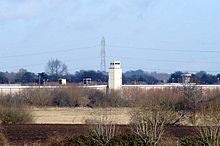Northern Ireland Prison Service
[3] The service's stated aim is "to improve public safety by reducing the risk of re-offending through the management and rehabilitation of offenders in custody".
It now has a reputation for being a very paranormally-active location and the gaol runs its own guided ghost walks and paranormal investigations.
This establishment began as Long Kesh Detention Centre in 1971, before being expanded with the building of the "H-blocks" in 1976 to become known as the Maze Prison.
Demolition of most of the site began in 2006, but much of the western part of the estate remains, including the hospital block and H-block 6, which are listed structures.
Plans to build a peace centre at the site broke down in 2019 when the European Union withdrew funding due to disagreements between the political parties.
Unionist parties feared that the site could become a shrine to IRA members such as Bobby Sands, who died in the hospital block while on hunger strike.
Much like officers of the Police Service of Northern Ireland, prison officers in Northern Ireland remain under a severe level of threat from dissident Republican terrorist groups, and - to a lesser extent - Loyalist paramilitary terrorist groups.
[6] Over thirty prison officers have been murdered in the line of duty in Northern Ireland, the vast majority by paramilitary terrorist groups.
The most recent murders were that of David Black, shot dead on his way to work in 2012, and Adrian Ismay, who died in hospital eleven days after an IED detonated under his vehicle in 2016.
[6] Officers may also avail of a personal protection weapon (PPW), although unlike their Police counterparts this is not mandatory.
[11] Prison Officers may carry weapons and use reasonable force (as sworn constables) to protect people.




